The Daily Observer London Desk: Reporter- Sarah Marshal
Cubans face a precarious present and an uncertain future. While the government focuses on the recovery of the tourism sector, people’s living conditions are driving the largest migratory exodus in the country’s history.
Inflation, the economic blockade and mismanagement mean many are unable to meet their basic needs.
The main focus of this project is to document the dismal housing situation in Old Havana, a reflection of the country’s wider collapse. Some sources suggest the government allows buildings to collapse in order to be able to buy them cheaply and convert them into tourism infrastructure.
Those who have lost their homes, mostly women and children, live in shelters, squat or try to repair their homes on the black market, the only place where they can find materials, even though they are overpriced.
The voices in this report reveal a reality that differs from the image of a Caribbean paradise, of life in dilapidated buildings among rats, bedbugs, cockroaches and damp, with suffering continuous power and water cuts and only very limited purchasing power.
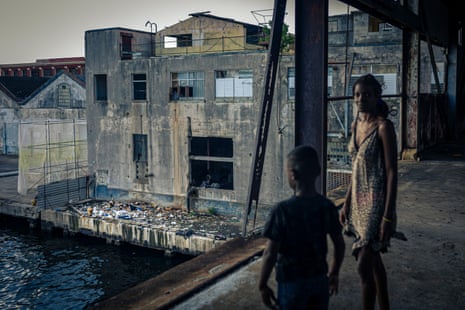
- Yurislandi, 8, and Sally, 32, observe the accumulation of waste at the La Coubre shelter in a formerly abandoned port office
Forty people who have lost their homes living in the La Coubre shelter. They throw their rubbish out of their windows because it’s difficult for them to feel the place as their own.

- Sally, 32, and Niovis, 33, cut up the piece of chicken they have left to get through the next 23 days until the end of the month
Neither Sally nor Niovis work. They have a special card for food but it has been suspended and Sally is showing signs of malnutrition. The sisters lived in a collapsed building at 317 Muralla Street. They were told they would be there for four months, but that was five years ago.
The authorities told them they would repair their house, but they did not and it eventually collapsed. Niovis says this is very common in Havana, especially after the hurricane season between June and October. Luckily, the girls were out when it happened.
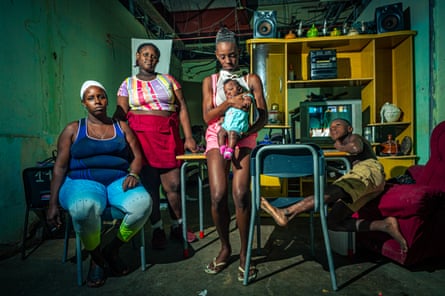
- From left to right, Jani, 34, with her children – Eliani, 11, Leyani, 16 with her three-month-old daughter Silenai and Yurislandi, 8
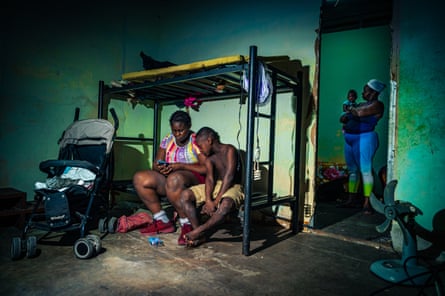
Jani’s biggest problems are her family’s overcrowded shelter and the presence of cockroaches, rats and damp. When Leyanis was pregnant, a cockroach got into her ear while she was sleeping and she required medical attention.
The government provided bunk beds for the six people in the family, but the mattresses are infested with fleas. The family spends entire days without safe drinking water and the children have serious difficulties focusing on their studies. When they came to the shelter to avoid the imminent collapse of their former home, Leyanis was a child. Now she is a mother.
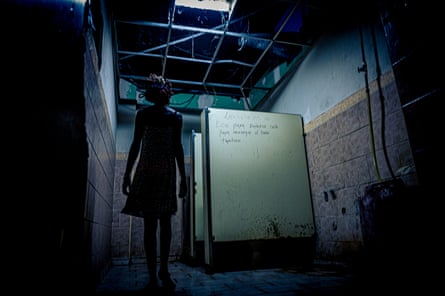
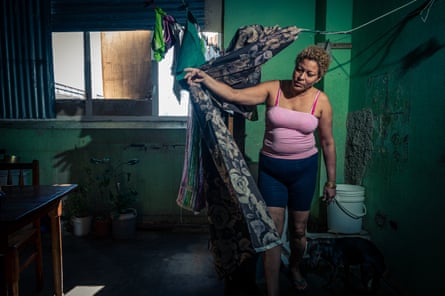
- Judit, 51, pulls back the curtain in front of the bath she has built herself in the room where she lives with her daughter Dianela, 18 and son Juan, 12
The shared toilets are a source of tension. They don’t have running water so extra care has to be taken with cleanliness, and that generates arguments between neighbours.
Judit has built her own bath to get more privacy, which is hard to find in these overcrowded places. She was being abused by her ex-partner and ran away as soon as she regained her strength. She spent almost four years renting, but she could not support herself and her two children on her account’s salary. She feels the only option she has to live decently is to leave the country, following the fate of millions of Cubans.
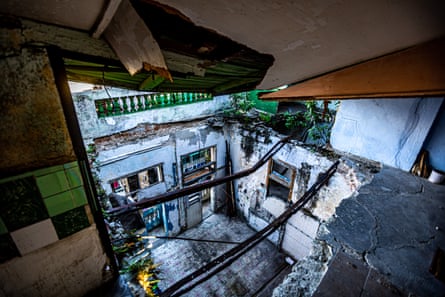

- Marlene prays as she holds a photo of her deceased parents, with her daughter Keyla María, 17 in La Coubre shelter
Marlene, 50, says her experience in the shelter may affect them for the rest of their lives. Her daughter, Keyla María, is traumatised, like so many other children living here. Marlene’s mother had lung cancer and in the shelter’s living conditions her health deteriorated drastically. ‘‘She lived badly, with suffering, with agony, and I begged that she could live the remaining months of her life in dignity, but it did not happen.’’

The residents are constantly trying to get the authorities to to repair the building. They have also asked for the materials to do the work themselves, but none have been forthcoming. The children at the shelter are forced to mature early. The older ones strive to help the family get by. Daian, 17, sells soft drinks on the street to bring in some money.
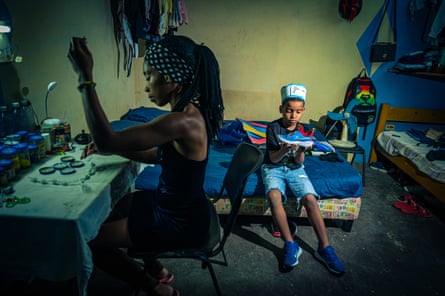
- Artelis, 31, makes religious jewellery in the shelter while her son Bryan, 7, holds the trainers his father sent from the US

Artelis, 31, was in her apartment with her son when their building collapsed. Their block started to degrade in 1984 and it collapsed in 2018. They had to live on the street for eight days. The government said it would compensate her for her furniture, but this never happened.
Bryan is often ill because of the cold and mosquitos in the shelter. His father lives in the US and sends money home. Remittances account for about 6% of the country’s GDP. Thanks to this and the little income Artelis makes she can just about cover her and Bryan’s basic needs. She is aware that it will be difficult to find a safer space for his son to live, so she intends to send him to his father when he gets a little older.
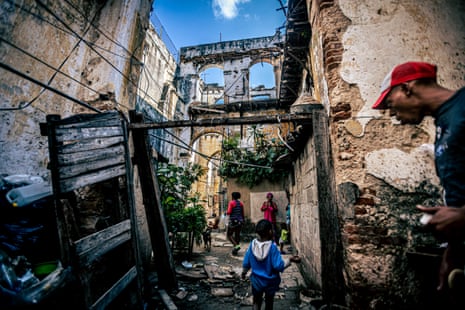
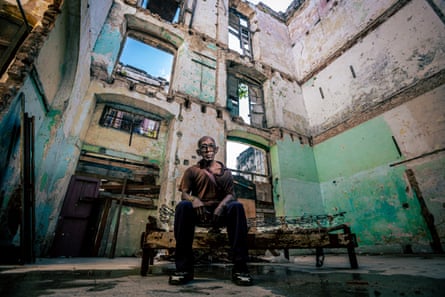
- Jesus, 78, sits on the remains of a bed at 62 Cuba Street, where lived before it collapsed
Many families refuse to be relocated into shelters for fear of losing their property rights to the government or a foreign investor. Those who stay live with the constant risk of collapse. At the entrance of this building, people sell materials they have salvaged from other destroyed houses. Those who engage in these activities are called “termites”.
The last part that collapsed was the apartment of Jesus, 78, two months after Hurricane Ian in 2022. He had lived there for 15 years.
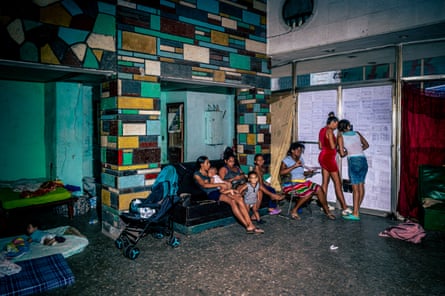
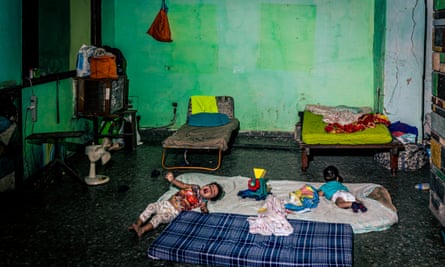
In Old Havana, former offices have become home to nine women and their eight children. They left their former homes because of overcrowding, poor conditions and mental health issues.

Nine families continued living in this building hoping that it would be repaired. Two of its floors collapsed in July 2020 and with the explosion of the adjacent Saratoga Hotel in 2022, its condition deteriorated significantly. The inhabitants moved refused to be relocated into a shelter because of the terrible conditions. The families spent years asking the authorities for help to save the building, but none came. This situation is especially common in Old Havana, the main tourist area of the city. Here luxury hotels coexist with buildings on the verge of collapse, in a clear process of gentrification sponsored by the government itself.
In their eagerness to boost tourism after the pandemic, the authorities are turning heritage buildings into hotels, which bring in foreign currency for the upper echelons of power. Meanwhile it only built 58% of the housing planned for 2022.
This model contrasts with that of the Cuban revolution, which was based on free usufruct. Large hotels and mansions were expropriated and used to create apartments for the middle and lower classes. None of these people own their homes, and they are not entitled to any compensation when they collapse.




